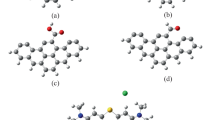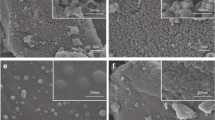Abstract
In this study, a new activated carbon (AC)-supported Co-based catalyst was synthesized from a biomass mixture by single-step pyrolysis for tetracycline (TC) degradation with persulfate (PS). The catalyst was characterized by BET-surface area, total pore volume, pore size, SEM, EDS, XRD, and VSM analysis. Its catalytic performance in the oxidative TC degradation was investigated depending on catalyst dosage, PS concentration, contact time, pH, and co-existing anion. The results show that the catalyst has 515.46 m2/g surface area, 0.2661 cm3/g pore volume, 79.14% C, and 14.63% Co. The catalyst exhibited high catalytic activity in oxidative degradation of TC with PS. One hundred percent mineralization could be achieved at the conditions of 0.5 g/L of catalyst dosage, 1 mM PS, pH 5.88, and 45 min. Quenching tests showed that the catalyst successively activated PS to generate SO4·− and OH·. However, SO4·− was identified as the main oxidizing radical in TC degradation. TC degradation was found to fit to first-order kinetics. The activation energy of the reaction was calculated to be 7.095 kJ/mol. Unlike conventional impregnation and precipitation methods applied for AC-supported catalyst synthesis, a superior catalyst can be obtained from cheap and abundant biomasses and Co-salt by a single-step pyrolysis. The high catalytic performance of the catalyst and short degradation period show that it can be a promising catalyst for degradation organic pollutants with PS.








Similar content being viewed by others
References
Bhatnagar A, Sillanpää M (2017) Removal of natural organic matter (NOM) and its constituents from water by adsorption – a review. Chemosphere 166:497–510
Oller I, Malato S, Sánchez-Pérez J (2011) Combination of advanced oxidation processes and biological treatments for wastewater decontamination—a review. Sci Total Environ 409:4141–4166
Yang Q, Ma Y, Chen F, Yao F, Sun J, Wang S, Yi K, Hou L, Li X, Wang D (2019) Recent advances in photo-activated sulfate radical-advanced oxidation process (SR-AOP) for refractory organic pollutants removal in water. Chem Eng J 122149
Babu DS, Srivastava V, Nidheesh P, Kumar MS (2019) Detoxification of water and wastewater by advanced oxidation processes. Sci Total Environ 133961
Ribeiro AR, Nunes OC, Pereira MF, Silva AM (2015) An overview on the advanced oxidation processes applied for the treatment of water pollutants defined in the recently launched Directive 2013/39/EU. Environ Int 75:33–51
Anipsitakis GP, Dionysiou DD (2003) Degradation of organic contaminants in water with sulfate radicals generated by the conjunction of peroxymonosulfate with cobalt. Environ Sci Technol 37:4790–4797
Devi P, Das U, Dalai AK (2016) In-situ chemical oxidation: principle and applications of peroxide and persulfate treatments in wastewater systems. Sci Total Environ 571:643–657
Ghanbari F, Moradi M (2017) Application of peroxymonosulfate and its activation methods for degradation of environmental organic pollutants. Chem Eng J 310:41–62
Wang J, Wang S (2018) Activation of persulfate (PS) and peroxymonosulfate (PMS) and application for the degradation of emerging contaminants. Chem Eng J 334:1502–1517
Hu P, Long M (2016) Cobalt-catalyzed sulfate radical-based advanced oxidation: a review on heterogeneous catalysts and applications. Appl Catal B Environ 181:103–117
Stoyanova M, Slavova I, Ivanova V (2014) Catalytic performance of supported nanosized cobalt and iron–cobalt mixed oxides on MgO in oxidative degradation of Acid Orange 7 azo dye with peroxymonosulfate. Appl Catal A Gen 476:121–132
Zhang W, Tay HL, Lim SS, Wang Y, Zhong Z, Xu R (2010) Supported cobalt oxide on MgO: highly efficient catalysts for degradation of organic dyes in dilute solutions. Appl Catal B Environ 95:93–99
Muhammad S, Saputra E, Sun H, Ang H-M, Tadé MO, Wang S (2013) Removal of phenol using sulphate radicals activated by natural zeolite-supported cobalt catalysts. Water Air Soil Pollut 224:1721
Lin K-YA, Chang H-A (2015) Zeolitic Imidazole Framework-67 (ZIF-67) as a heterogeneous catalyst to activate peroxymonosulfate for degradation of rhodamine B in water. J Taiwan Inst Chem Eng 53:40–45
Saputra E, Budihardjo MA, Bahri S, Pinem JA (2016) Cobalt-exchanged natural zeolite catalysts for catalytic oxidation of phenolic contaminants in aqueous solutions. J Water Process Eng 12:47–51
Yang F, Zhou S, Wang H, Long S, Liu X, Kong Y (2016) A metal-assisted templating route (S 0 M+ I−) for fabricating thin-layer CoO covered on the channel of nanospherical-HMS with improved catalytic properties. Dalton Trans 45:6371–6382
Hardjono Y, Sun H, Tian H, Buckley C, Wang S (2011) Synthesis of Co oxide doped carbon aerogel catalyst and catalytic performance in heterogeneous oxidation of phenol in water. Chem Eng J 174:376–382
Shi P, Dai X, Zheng H, Li D, Yao W, Hu C (2014) Synergistic catalysis of Co3O4 and graphene oxide on Co3O4/GO catalysts for degradation of Orange II in water by advanced oxidation technology based on sulfate radicals. Chem Eng J 240:264–270
Sun H, Tian H, Hardjono Y, Buckley CE, Wang S (2012) Preparation of cobalt/carbon-xerogel for heterogeneous oxidation of phenol. Catal Today 186:63–68
Shukla PR, Wang S, Sun H, Ang HM, Tadé M (2010) Activated carbon supported cobalt catalysts for advanced oxidation of organic contaminants in aqueous solution. Appl Catal B Environ 100:529–534
Duan X, Sun H, Kang J, Wang Y, Indrawirawan S, Wang S (2015) Insights into heterogeneous catalysis of persulfate activation on dimensional-structured nanocarbons. ACS Catal 5:4629–4636
Huang Z, Bao H, Yao Y, Lu W, Chen W (2014) Novel green activation processes and mechanism of peroxymonosulfate based on supported cobalt phthalocyanine catalyst. Appl Catal B Environ 154:36–43
Wang C, Yang Q, Li Z, Lin K-YA, Tong S (2019) A novel carbon-coated Fe-C/N composite as a highly active heterogeneous catalyst for the degradation of Acid Red 73 by persulfate. Sep Purif Technol 213:447–455
Zou W, Gao B, Ok YS, Dong L (2018) Integrated adsorption and photocatalytic degradation of volatile organic compounds (VOCs) using carbon-based nanocomposites: a critical review. Chemosphere 218:845–859
Dias JM, Alvim-Ferraz MC, Almeida MF, Rivera-Utrilla J, Sánchez-Polo M (2007) Waste materials for activated carbon preparation and its use in aqueous-phase treatment: a review. J Environ Manag 85:833–846
Yahya MA, Al-Qodah Z, Ngah CZ (2015) Agricultural bio-waste materials as potential sustainable precursors used for activated carbon production: a review. Renew Sust Energ Rev 46:218–235
Akçakal Ö, Şahin M, Erdem M (2019) Synthesis and characterization of high-quality activated carbons from hard-shelled agricultural wastes mixture by zinc chloride activation. Chem Eng Commun 206:888–897
Boehm HP (2002) Surface oxides on carbon and their analysis: a critical assessment. Carbon 40:145–149
Carrott P, Nabais JV, Carrott MR, Menéndez J (2001) Thermal treatments of activated carbon fibres using a microwave furnace. Microporous Mesoporous Mater 47:243–252
Rashwan WE, Fathy NA, Elkhouly SM (2018) A novel catalyst of ceria-nanorods loaded on carbon xerogel for catalytic wet oxidation of methyl green dye. J Taiwan Inst Chem Eng 88:234–242
Fathy NA, El-Khouly SM, Hassan NA, Awad RM (2017) Free-and Ni-doped carbon xerogels catalysts for wet peroxide oxidation of methyl orange. J Water Process Eng 16:21–27
Fang C, Gao X, Zhang X, Zhu J, Sun S-P, Wang X, Wu WD, Wu Z (2019) Facile synthesis of alkaline-earth metal manganites for the efficient degradation of phenolic compounds via catalytic ozonation and evaluation of the reaction mechanism. J Colloid Interface Sci 551:164–176
Martins AC, Cazetta AL, Pezoti O, Souza JR, Zhang T, Pilau EJ, Asefa T, Almeida VC (2017) Sol-gel synthesis of new TiO2/activated carbon photocatalyst and its application for degradation of tetracycline. Ceram Int 43:4411–4418
Springer V, Barreiros L, Avena M, Segundo MA (2018) Nickel ferrite nanoparticles for removal of polar pharmaceuticals from water samples with multi-purpose features. Adsorption 24:431–441
Nguyen V-T, Nguyen T-B, Chen C-W, Hung C-M, Huang C, Dong C-D (2019) Cobalt-impregnated biochar (Co-SCG) for heterogeneous activation of peroxymonosulfate for removal of tetracycline in water. Bioresour Technol 292:121954
Li J, Xu M, Yao G, Lai B (2018) Enhancement of the degradation of atrazine through CoFe2O4 activated peroxymonosulfate (PMS) process: Kinetic, degradation intermediates, and toxicity evaluation. Chem Eng J 348:1012–1024
Xu M, Li J, Yan Y, Zhao X, Yan J, Zhang Y, Lai B, Chen X, Song L (2019) Catalytic degradation of sulfamethoxazole through peroxymonosulfate activated with expanded graphite loaded CoFe2O4 particles. Chem Eng J 369:403–413
Armstrong DA, Huie RE, Lymar S, Koppenol WH, Merényi G, Neta P, Stanbury DM, Steenken S, Wardman P (2013) Standard electrode potentials involving radicals in aqueous solution: inorganic radicals. BioInorgan React Mech 9:59–61
Fang G, Gao J, Dionysiou DD, Liu C, Zhou D (2013) Activation of persulfate by quinones: free radical reactions and implication for the degradation of PCBs. Environ Sci Technol 47:4605–4611
Deng J, Feng S, Zhang K, Li J, Wang H, Zhang T, Ma X (2017) Heterogeneous activation of peroxymonosulfate using ordered mesoporous Co3O4 for the degradation of chloramphenicol at neutral pH. Chem Eng J 308:505–515
Lu S, Wang G, Chen S, Yu H, Ye F, Quan X (2018) Heterogeneous activation of peroxymonosulfate by LaCo1-xCuxO3 perovskites for degradation of organic pollutants. J Hazard Mater 353:401–409
Zhu K, Xu H, Chen C, Ren X, Alsaedi A, Hayat T (2019) Encapsulation of Fe0-dominated Fe3O4/Fe0/Fe3C nanoparticles into carbonized polydopamine nanospheres for catalytic degradation of tetracycline via persulfate activation. Chem Eng J 372:304–311
Cao J, Lai L, Lai B, Yao G, Chen X, Song L (2019) Degradation of tetracycline by peroxymonosulfate activated with zero-valent iron: performance, intermediates, toxicity and mechanism. Chem Eng J 364:45–56
Jiang X, Guo Y, Zhang L, Jiang W, Xie R (2018) Catalytic degradation of tetracycline hydrochloride by persulfate activated with nano Fe0 immobilized mesoporous carbon. Chem Eng J 341:392–401
Pi Z, Li X, Wang D, Xu Q, Tao Z, Huang X, Yao F, Wu Y, He L, Yang Q (2019) Persulfate activation by oxidation biochar supported magnetite particles for tetracycline removal: Performance and degradation pathway. J Clean Prod 235:1103–1115
Zhong Q, Lin Q, Huang R, Fu H, Zhang X, Luo H, Xiao R (2020) Oxidative degradation of tetracycline using persulfate activated by N and Cu codoped biochar. Chem Eng J 380:122608
He Y, Huang Z, Ma Z, Yao B, Liu H, Hu L, Zhao Q, Yang Q, Liu D, Du D (2019) Highly efficient photocatalytic performance and mechanism of α-ZnTcPc/g-C3N4 composites for methylene blue and tetracycline degradation under visible light irradiation. Appl Surf Sci 143834
Jiang L, Yuan X, Zeng G, Liang J, Wu Z, Yu H, Mo D, Wang H, Xiao Z, Zhou C (2019) Nitrogen self-doped g-C3N4 nanosheets with tunable band structures for enhanced photocatalytic tetracycline degradation. J Colloid Interface Sci 536:17–29
Funding
This work was supported by the Scientific and Technological Research Council of Turkey (TUBITAK) (grant number 117Y300).
Author information
Authors and Affiliations
Corresponding author
Additional information
Publisher’s Note
Springer Nature remains neutral with regard to jurisdictional claims in published maps and institutional affiliations.
Rights and permissions
About this article
Cite this article
Erdem, H., Erdem, M. Synthesis and characterization of a novel activated carbon–supported cobalt catalyst from biomass mixture for tetracycline degradation via persulfate activation. Biomass Conv. Bioref. 12, 3513–3524 (2022). https://doi.org/10.1007/s13399-020-00963-z
Received:
Revised:
Accepted:
Published:
Issue Date:
DOI: https://doi.org/10.1007/s13399-020-00963-z




